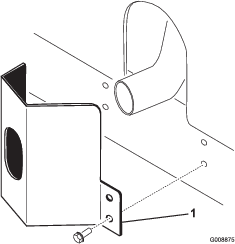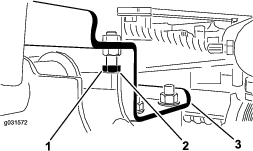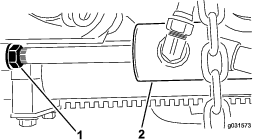| Maintenance Service Interval | Maintenance Procedure |
|---|---|
| Before each use or daily |
|
Introduction
This machine is a multi-purpose machine intended to be used by professional, hired operators in commercial applications. It is designed primarily for mowing grass on well-maintained lawns in parks, golf courses, sports fields, and on commercial grounds. Using this product for purposes other than its intended use could prove dangerous to you and bystanders.
Read this information carefully to learn how to operate and maintain your product properly and to avoid injury and product damage. You are responsible for operating the product properly and safely.
Visit www.Toro.com for product safety and operation training materials, accessory information, help finding a dealer, or to register your product.
Whenever you need service, genuine Toro parts, or additional information, contact an Authorized Service Dealer or Toro Customer Service and have the model and serial numbers of your product ready. Figure 1 identifies the location of the model and serial numbers on the product. Write the numbers in the space provided.
Important: With your mobile device, you can scan the QR code on the serial number decal (if equipped) to access warranty, parts, and other product information.

This manual identifies potential hazards and has safety messages identified by the safety-alert symbol (Figure 2), which signals a hazard that may cause serious injury or death if you do not follow the recommended precautions.

This manual uses 2 words to highlight information. Important calls attention to special mechanical information and Note emphasizes general information worthy of special attention.
This product complies with all relevant European directives; for details, please see the separate product specific Declaration of Conformity (DOC) sheet.
It is a violation of California Public Resource Code Section 4442 or 4443 to use or operate the engine on any forest-covered, brush-covered, or grass-covered land unless the engine is equipped with a spark arrester, as defined in Section 4442, maintained in effective working order or the engine is constructed, equipped, and maintained for the prevention of fire.
The enclosed engine owner's manual is supplied for information regarding the US Environmental Protection Agency (EPA) and the California Emission Control Regulation of emission systems, maintenance, and warranty. Replacements may be ordered through the engine manufacturer.
Warning
CALIFORNIA
Proposition 65 Warning
Diesel engine exhaust and some of its constituents are known to the State of California to cause cancer, birth defects, and other reproductive harm.
Battery posts, terminals, and related accessories contain lead and lead compounds, chemicals known to the State of California to cause cancer and reproductive harm. Wash hands after handling.
Use of this product may cause exposure to chemicals known to the State of California to cause cancer, birth defects, or other reproductive harm.
Safety
This machine has been designed in accordance with EN ISO 5395 and ANSI B71.4-2017.
General Safety
This product is capable of amputating hands and feet and of throwing objects. Always follow all safety instructions to avoid serious personal injury.
-
Read and understand the contents of this Operator’s Manual before starting the engine.
-
Use your full attention while operating the machine. Do not engage in any activity that causes distractions; otherwise, injury or property damage may occur.
-
Do not operate the machine without all guards and other safety protective devices in place and functioning properly on the machine.
-
Keep your hands and feet away from rotating parts. Keep clear of the discharge opening.
-
Keep bystanders and children out of the operating area. Never allow children to operate the machine.
-
Shut off the engine, remove the key (if equipped), and wait for all movement to stop before you leave the operator’s position, Allow the machine to cool before adjusting, servicing, cleaning, or storing it.
Improperly using or maintaining this machine can result in injury.
To reduce the potential for injury, comply with these safety instructions
and always pay attention to the safety-alert symbol  , which means Caution, Warning,
or Danger—personal safety instruction. Failure to comply with
these instructions may result in personal injury or death.
, which means Caution, Warning,
or Danger—personal safety instruction. Failure to comply with
these instructions may result in personal injury or death.
Safety and Instructional Decals
 |
Safety decals and instructions are easily visible to the operator and are located near any area of potential danger. Replace any decal that is damaged or missing. |





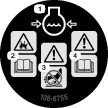
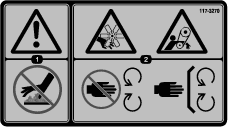
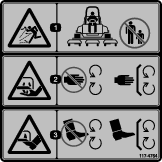




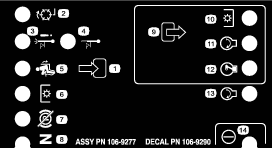
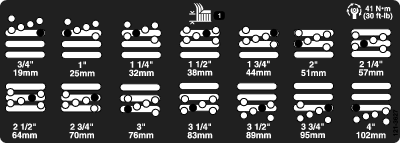
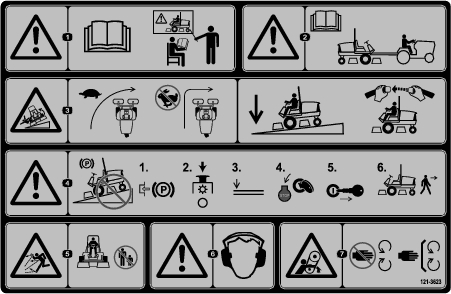
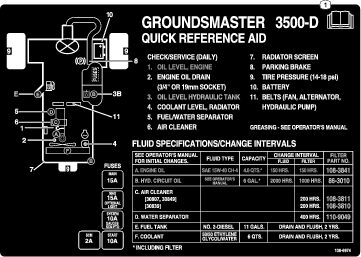

Setup
Note: Determine the left and right sides of the machine from the normal operating position.
Activating, Charging, and Connecting the Battery
Note: If the battery is not filled with electrolyte or activated, purchase bulk electrolyte with 1.26 specific gravity from a local battery-supply outlet and add it to the battery.
Danger
Battery electrolyte contains sulfuric acid which is fatal when consumed and causes severe burns.
-
Do not drink electrolyte and avoid contact with skin, eyes, or clothing. Wear safety glasses to shield your eyes and rubber gloves to protect your hands.
-
Fill the battery where clean water is always available for flushing the skin.
-
Remove the battery cover (Figure 3).
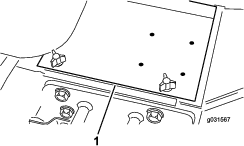
-
Remove the filler caps from the battery and slowly fill each cell until the electrolyte is just above the plates.
-
Install the filler caps and connect a 3 to 4 A battery charger to the battery posts.
Note: Charge the battery at a rate of 3 to 4 A for 4 to 8 hours.
Warning
Charging the battery produces gasses that can explode.
-
Keep sparks and flames away from battery.
-
Never smoke near the battery.
-
-
When the battery is charged, disconnect the charger from the electrical outlet and battery posts.
-
Remove the filler caps.
-
Slowly add electrolyte to each cell until the level is up to the fill ring.
Important: Do not overfill the battery. Electrolyte will overflow onto other parts of the machine and severe corrosion and deterioration will result.
-
Install the filler caps.
-
Install the positive cable (red) to the positive (+) terminal and the negative cable (black) to the negative (–) terminal of the battery and secure them with the bolts and nuts (Figure 4).
Note: Ensure that the positive (+) terminal is all the way onto the post and the cable is positioned snug to the battery. The cable must not contact the battery cover.
Warning
Incorrect battery cable routing could damage the tractor and cables, causing sparks. Sparks can cause the battery gases to explode, resulting in personal injury.
-
Always disconnect the negative (black) battery cable before disconnecting the positive (red) cable.
-
Always connect the positive (red) battery cable before connecting the negative (black) cable.
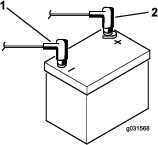
Important: If you ever remove the battery, install the battery-clamp bolts with the bolt heads positioned on the bottom side and the nuts on the top side. If the clamp bolts are reversed, they may interfere with the hydraulic tubes when shifting the cutting units.
-
-
Coat both battery connections with Grafo 112X (skin over) grease (Toro Part No. 505-47), petroleum jelly, or light grease to prevent corrosion.
-
Slide the rubber boot over the positive terminal to prevent a possible short from occurring.
-
Install the battery cover.
Checking the Angle Indicator
Parts needed for this procedure:
| Inclinometer | 1 |
-
Park the machine on a flat, level surface.
-
Verify that the machine is level by placing a handheld inclinometer (supplied with the machine) on the frame cross rail, by the fuel tank (Figure 5).
Note: The inclinometer should read at 0° when viewed from the operating position.
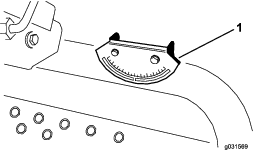
-
If the inclinometer does not read 0°, move the machine to a different location to obtain a 0° reading.
Note: The angle indicator, mounted on the machine, should now read 0° also.
-
If the angle indicator does not read 0°, loosen the 2 screws and nuts securing the angle indicator to the mounting bracket, adjust the indicator to obtain a 0° reading, and tighten the bolts.
Installing the CE Decal
Parts needed for this procedure:
| Safety decal | 1 |
| Production year decal | 1 |
| CE Mark decal | 1 |
If this machine will be used for CE, affix the CE-warning decal over the corresponding English warning decal.
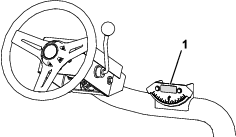
If this machine will be used for CE, affix the production year decal and CE mark decal next to the serial plate (Figure 7).
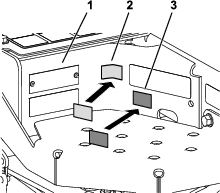
Installing the Hood Latch
Parts needed for this procedure:
| Hood-latch bracket | 1 |
| Rivet | 2 |
| Washer | 1 |
| Screw (1/4 x 2 inches) | 1 |
| Locknut (1/4 inch) | 1 |
-
Unhook the hood latch from the hood-latch bracket.
-
Remove the 2 rivets securing the hood-latch bracket to the hood (Figure 8).
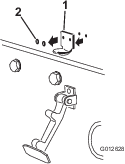
-
Remove the hood-latch bracket from the hood.
-
While aligning the mounting holes, position the CE lock bracket and the hood-latch bracket onto the hood (Figure 9).
Note: The lock bracket must be against the hood. Do not remove the bolt and nut from the lock-bracket arm.
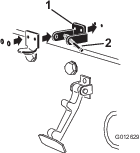
-
Align the washers with the holes on the inside of the hood.
-
Rivet the brackets and the washers to the hood (Figure 9).
-
Hook the latch onto the hood-latch bracket (Figure 10).
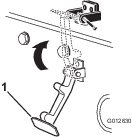
-
Install the bolt into the other arm of the hood-latch bracket to lock the latch in position (Figure 11). Tighten the bolt but do not tighten the nut.
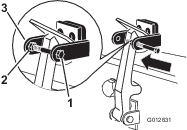
Installing the Exhaust Guard
Adjusting the Lift Arms
-
Start the engine, raise the cutting units, and ensure that the clearance between each lift arm and the floor-plate bracket is 5 to 8 mm (0.18 to 0.32 inch) as shown in Figure 13.
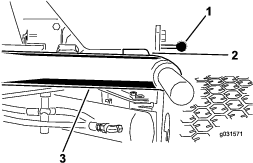
If the clearance is not in this range, adjust it as follows:
-
Ensure that the clearance between each lift arm and stop bolt is 0.13 to 1.02 mm (0.005 to 0.040 inch) as shown in Figure 14.
Note: If the clearance is not in this range, adjust the stop bolts to attain the proper clearance.
-
Start the engine, raise the cutting units, and ensure that the clearance between the wear strap on the top of the rear-cutting-unit wear bar and the bumper strap is 0.51 to 2.54 mm (0.02 to 0.10 inch) as shown in Figure 16.
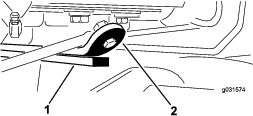
If the clearance is not in this range, adjust the rear cylinder as follows:
Note: If the rear-lift arm clunks during transport, you can reduce clearance.
-
Lower the cutting units and back off the jam nut on the cylinder (Figure 17).

-
Grasp the cylinder rod close to the nut with a pliers and rag, and rotate the rod.
-
Raise the cutting units and check the clearance.
Note: Repeat the procedure if required.
-
Tighten the clevis jam nut.
-
Important: Lack of clearance at the front stops or rear wear bar could damage the lift arms.
Adjusting the Carrier Frame
Adjusting the Front Cutting Units
The front and rear cutting units require different mounting positions. The front cutting unit has 2 mounting positions depending on what height of cut and degree of cutting unit rotation you desire.
-
For heights of cut in the 2 to 7.6 cm (3/4 to 3 inches) range, mount the front carrier frames in the lower, front mounting holes (Figure 18).
Note: This permits more up travel of the cutting units relative to the machine when approaching sudden changes in uphill terrain. It does, however, limit the clearance of the chamber to the carrier when cresting sharp, small hills.

-
For heights of cut in the 6.3 to 10 cm (2-1/2 to 4 inches) range, mount the front carrier frames in the upper, front mounting holes (Figure 18).
Note: This increases the chamber to carrier clearance due to the higher position of the cutting chamber, but causes the cutting unit to reach its maximum up travel more quickly.
Adjusting the Rear Cutting Unit
The front and rear cutting units require different mounting positions. The rear cutting unit has 1 mounting position for proper alignment with the Sidewinder® unit under the frame.
For all heights of cut, mount the rear cutting unit in the rear mounting holes (Figure 18).
Adjusting the Height of Cut
Important: This rotary cutting unit often cuts approximately 6 mm (1/4 inch) lower than a reel cutting unit with the same bench setting. It may be necessary to have the rotary cutting units bench set 6 mm (1/4 inch) above that of the reels cutting in the same area.
Important: Access to the rear cutting units is greatly improved by removing the cutting unit from the machine. If the machine is equipped with a Sidewinder® unit, side-wind the cutting units to the right, remove the rear cutting unit, and slide it out to the right side.
-
Lower the cutting unit to the ground, shut off the engine, and remove the ignition key.
-
Loosen the bolt securing each height-of-cut bracket to the height-of-cut plate (front and each side) as shown in Figure 19.

-
Beginning with the front adjustment, remove the bolt.
-
While supporting the chamber, remove the spacer (Figure 19).
-
Move the chamber to the desired height of cut and install a spacer into the designated height-of-cut hole and slot (Figure 20).

-
Position the tapped plate in line with the spacer.
-
Install the bolt (finger tight).
-
Repeat steps 4 to 7 for each side adjustment.
-
Tighten the 3 bolts to 41 N∙m (30 ft-lb).
Note: Tighten the front bolt first.
Note: Adjustments of more than 3.8 cm (1-1/2 inches) may require temporary assembly to an intermediate height to prevent binding (for example, changing from 3.1 to 7 cm (1-1/4 to 2-3/4 inches) height of cut).
Adjusting the Roller Scraper
The optional rear roller scraper functions best when there is an even gap of 0.5 to 1 mm (0.02 to 0.04 inch) between the scraper and the roller.
-
Loosen the grease fitting and the mounting screw (Figure 21).
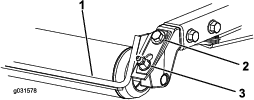
-
Slide the scraper up or down until you obtain a gap of 0.5 to 1 mm (0.02 to 0.04 inch) between the rod and the roller.
-
Tighten the grease fitting and screw to 41 N∙m (30 ft-lb) in an alternating sequence.
Installing the Mulching Baffle
Contact your authorized Toro distributor for the correct mulching baffle.
-
Thoroughly clean debris from the mounting holes on the rear wall and left wall of the chamber.
-
Install the mulching baffle in the rear opening and secure it with 5 flange-head bolts (Figure 22).
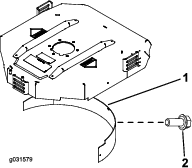
-
Verify that the mulching baffle does not interfere with the tip of the blade and does not protrude inside the surface of the rear chamber wall.
Danger
Using the high-lift blade with the mulching baffle could cause the blade to break, resulting in personal injury or death.
Do not use the high-lift blade with the baffle.
Product Overview

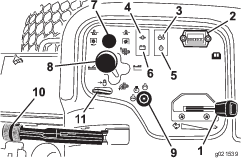
Traction Pedals
Press the forward traction pedal to move forward. Press reverse traction pedal to move backward or to assist in stopping when moving forward (Figure 23).
Note: Allow the pedal to move or move it to the NEUTRAL position to stop the machine.
Tilt-Steering Lever
Pull the tilt-steering lever back to tilt the steering wheel to the desired position, then push the lever forward to tighten (Figure 23).
Parking Brake
Whenever you shut off the engine, engage the parking brake to prevent accidental movement of the machine. To engage the parking brake, pull up on the lever (Figure 24).
Note: The engine shuts off when you press the traction pedal with the parking brake engaged.
Key Switch
The key switch is used to start, stop, and preheat the engine. The ignition switch has 3 positions: OFF, ON/PREHEAT, and START. Rotate the key to the ON/PREHEAT position until the glow-plug-indicator light goes out (approximately 7 seconds); then rotate the key to the START position to engage the starter motor. Release the key when the engine starts (Figure 24).
To shut off the engine, rotate the key to the OFF position.
Note: Remove the key from the switch to prevent accidental starting.
Seat-Adjustment Lever
Move the seat-adjustment lever on the side of the seat outward, slide the seat to the desired position, and release the lever to lock the seat into position (Figure 25).
Fuel Gauge
The fuel gauge registers the amount of fuel in the tank (Figure 25).
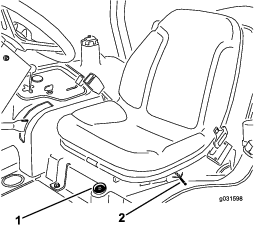
Hour Meter
The hour meter records the number of hours that you operate the machine with the key switch in the RUN position. Use these times for scheduling regular maintenance.
Engine-Coolant-Temperature Warning Light
The temperature warning light glows if the engine coolant temperature is too high. If the coolant temperature rises another 10°, the engine shuts off (Figure 24).
Glow-Plug-Indicator Light
The glow-plug-indicator light glows when the glow plugs are operating (Figure 24).
Oil-Pressure Warning Light
The oil-pressure warning light glows if the engine-oil pressure drops below a safe level (Figure 24). If the oil pressure is low, shut off the engine and determine the cause. Repair the engine-oil system before you start the engine again.
Lift-Lock Lever
Use the lift-lock lever to secure the lift switch (Figure 24), to the RAISE-DECK position, when performing maintenance on the cutting unit or when transporting between mowing locations.
Mow/Transport Slide
Using your heel, move the mow/transport slide to the left to transport, and to the right to mow (Figure 24).
Note: The cutting units operate only in the mow position.
Important: The mow speed is set at the factory to 9.7 km/h (6 mph). You can increase or decrease the mow speed by adjusting the speed-stop screw (Figure 26).
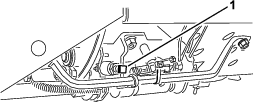
Indicator Slot
The indicator slot in the operator platform indicates when the cutting units are in the center position (Figure 23).
Throttle
Move the throttle forward to increase the engine speed and rearward to decrease the engine speed (Figure 24).
PTO Switch
The PTO switch has 2 positions: OUT (start) and IN (stop). Pull the PTO switch out to engage the cutting-unit blades. Push the switch in to disengage the cutting-unit blades (Figure 24).
Cutting-Unit Shift Lever
To lower the cutting units to the ground, move the cutting-unit shift lever forward. To raise the cutting units, pull the shift lever rearward to the RAISE position (Figure 24).
Note: The cutting units do not drop unless the engine is running.
Move the lever to the right or left to move the cutting units in the same direction.
Note: Do this only when the cutting units are raised or if they are on the ground and the machine is moving.
Note: The lever does not need to be held in the forward position while you are lowering the cutting units.
Alternator Light
The alternator light should be off when the engine is running (Figure 24).
Note: If it is on, check the charging system and repair it as necessary.
Note: Specifications and design are subject to change without notice.

| Description | Figure 27 reference | Dimension or Weight | |
| Overall width in mowing position | A | 192 cm (75-1/2 inches) | |
| Overall width in transport position | B | 184 cm (72-1/2 inches) | |
| Height | C | 197 cm (77-1/2 inches) | |
| Wheel-base width | D | 146 cm (57-1/2 inches) | |
| Wheel-base length | E | 166 cm (65-1/2 inches) | |
| Overall length in mowing position | F | 295 cm (116 inches) | |
| Overall length in transport position | G | 295 cm (116 inches) | |
| Ground clearance | 15 cm (6 inches) | ||
| Weight | 963 kg (2,124 lb) | ||
Note: Specifications and design are subject to change without notice.
Attachments/Accessories
A selection of Toro approved attachments and accessories is available for use with the machine to enhance and expand its capabilities. Contact your Authorized Service Dealer or authorized Toro distributor or go to www.Toro.com for a list of all approved attachments and accessories.
To ensure optimum performance and continued safety certification of the machine, use only genuine Toro replacement parts and accessories. Replacement parts and accessories made by other manufacturers could be dangerous, and such use could void the product warranty.
Operation
Before Operation
Note: Determine the left and right sides of the machine from the normal operating position.
Before Operation Safety
General Safety
-
Never allow children or untrained people to operate or service the machine. Local regulations may restrict the age of the operator. The owner is responsible for training all operators and mechanics.
-
Become familiar with the safe operation of the equipment, operator controls, and safety signs.
-
Shut off the engine, remove the key (if equipped), and wait for all movement to stop before you leave the operator’s position, Allow the machine to cool before adjusting, servicing, cleaning, or storing it.
-
Know how to stop the machine and shut off the engine quickly.
-
Check that operator-presence controls, safety switches, and guards are attached and functioning properly. Do not operate the machine unless they are functioning properly.
-
Before mowing, always inspect the machine to ensure that the blades, blade bolts, and cutting assemblies are in good working condition. Replace worn or damaged blades and bolts in sets to preserve balance.
-
Inspect the area where you will use the machine and remove all objects that the machine could throw.
Fuel Safety
-
Use extreme care in handling fuel. It is flammable and its vapors are explosive.
-
Extinguish all cigarettes, cigars, pipes, and other sources of ignition.
-
Use only an approved fuel container.
-
Do not remove the fuel cap or fill the fuel tank while the engine is running or hot.
-
Do not add or drain fuel in an enclosed space.
-
Do not store the machine or fuel container where there is an open flame, spark, or pilot light, such as on a water heater or other appliance.
-
If you spill fuel, do not attempt to start the engine; avoid creating any source of ignition until the fuel vapors have dissipated.
Adding Fuel
Recommended Fuel
Use only clean, fresh diesel fuel or biodiesel fuels with low (<500 ppm) or ultra low (<15 ppm) sulfur content. The minimum cetane rating should be 40. Purchase fuel in quantities that can be used within 180 days to ensure fuel freshness.
Important: Use of non-ultra low sulfur fuel causes damage to the engine emission system.
Fuel tank capacity: 42 L (11 US gallons)
Use summer-grade diesel fuel (No. 2-D) at temperatures above -7°C (20°F) and winter grade (No. 1-D or No. 1-D/2-D blend) below that temperature. Use of winter-grade fuel at lower temperatures provides lower flash point and cold-flow characteristics, which eases starting and reduces fuel filter plugging.
Use of summer-grade fuel above -7°C (20°F) contributes toward longer fuel-pump life and increased power compared to winter-grade fuel.
Important: Do not use kerosene or gasoline instead of diesel fuel. Failure to observe this caution damages the engine.
Using Biodiesel
This machine can also use a biodiesel-blended fuel of up to B20 (20% biodiesel, 80% petrodiesel).
Sulfur content: Ultra-low sulfur (<15 ppm)
Biodiesel fuel specification: ASTM D6751 or EN14214
Blended fuel specification: ASTM D975, EN590, or JIS K2204
Important: The petroleum diesel portion must be ultra-low sulfur.
Observe the following precautions:
-
Biodiesel blends may damage painted surfaces.
-
Use B5 (biodiesel content of 5%) or lesser blends in cold weather.
-
Monitor seals, hoses, gaskets in contact with fuel as they may degrade over time.
-
Fuel filter plugging may occur for a time after you convert to biodiesel blends.
-
For more information on biodiesel, contact your authorized Toro distributor.
Filling the Fuel Tank
-
Clean the area around the fuel-tank cap (Figure 28).
-
Remove the fuel-tank cap.
-
Fill the tank to the bottom of the filler neck. Do not overfill. Install the cap.
-
To prevent a fire hazard, wipe up any spilled fuel.
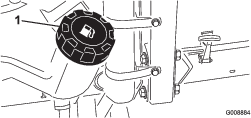
Note: If possible, fill the fuel tank after each use. This minimizes buildup of condensation inside the fuel tank.
Checking the Engine-Oil Level
Before you start the engine and use the machine, check the oil level in the engine crankcase; refer to Checking the Engine-Oil Level.
Checking the Cooling System
Before you start the engine and use the machine, check the cooling system; refer to Checking the Cooling System.
Checking the Hydraulic System
Before you start the engine and use the machine, check the hydraulic system; refer to Checking the Hydraulic Fluid Level.
Selecting a Blade
Standard Combination Sail
This blade was designed to provide excellent lift and dispersion in almost any condition. If more or less lift and discharge velocity is required, consider a different blade.
Attributes: Excellent lift and dispersion in most conditions
Angled Sail (Not CE Compliant)
The blade generally performs best in lower heights of cut—1.9 to 6.4 cm (3/4 to 2-1/2 inches).
Attributes:
-
Discharge remains more even at lower heights of cut.
-
Discharge has less tendency to throw left and thus a cleaner look around bunkers and fairways.
-
Lower power requirement at lower heights and dense turf.
High-Lift Parallel Sail (Not CE Compliant)
The blade generally performs better in the higher heights of cut—7 to 10 cm (2 to 4 inches).
Attributes:
-
More lift and higher discharge velocity
-
Sparse or limp turf is picked up significantly at higher heights of cut
-
Wet or sticky clippings are discharged more efficiently reducing congestion in the cutting unit.
-
Requires more horsepower to run
-
Tends to discharge further left and can tend to windrow at lower heights of cut
Warning
Using a high-lift blade with the mulching baffle could cause the blade to break, resulting in personal injury or death.
Do not use the high-lift blade with the mulching baffle.
Atomic Blade
This blade was designed to provide excellent leaf mulching.
Attribute: Excellent leaf mulching
Choosing Accessories
Optional Equipment Configurations
| Angle Sail Blade | High-Lift, Parallel-Sail Blade(Do not use with the mulching baffle)(Not CE Compliant) | Mulching Baffle | Roller Scraper | |
| Grass Cutting: 1.9 to 4.4 cm (3/4 to 1-3/4 inches) height of cut | Recommended in most applications | May work well in light or sparse turf | Has been shown to improve dispersion and after-cut performance on northern grasses that are cut at least 3 times per week and less than 1/3 of the grass blade is removed. Do not use with the high-lift, parallel-sail blade | Use it whenever the rollers build up with grass or large, flat grass clumps of grass are seen. The scrapers may increase clumping in certain applications. |
| Grass Cutting: 5 to 6.4 cm (2 to 2-1/2 inches) height of cut | Recommended for thick or lush turf | Recommended for light or sparse turf | ||
| Grass Cutting: 7 to 10 cm (2-3/4 to 4 inches) height of cut | May work well in lush turf | Recommended in most applications | ||
| Leaf Mulching | Recommended for use with the mulching baffle | Not Allowed | Use with combination sail or angle sail blade only | |
| Pros | Even discharge at lower height of cut; cleaner look around bunkers and fairways; lower power requirements | More lift and higher discharge velocity; sparse or limp turf is picked up at high height of cut; wet or sticky clippings are discharged efficiently | May improve dispersion and appearance in certain grass cutting applications; very good for leaf mulching | Reduces roller buildup in certain applications |
| Cons | Does not lift the grass well in high height-of-cut applications; wet or sticky grass has a tendency to build up in the chamber, leading to poor quality of cut and higher power requirements | Requires more power to run in some applications; tends to windrow at lower height of cut in lush grass; do not use with the mulching baffle | Grass will build up in the chamber if you attempt to remove too much grass with the baffle in place |
Checking the Safety-Interlock System
Caution
If the safety-interlock switches are disconnected or damaged, the machine could operate unexpectedly and cause personal injury.
-
Do not tamper with the safety systems.
-
Check the operation of the switches daily and replace any damaged switches before operating the machine.
-
Drive the machine slowly to a large, open area.
-
Lower the cutting unit(s), shut off the engine, and engage the parking brake.
-
While sitting on the seat, the engine must not start with either the cutting-unit switch engaged or the traction pedal engaged.
Note: Correct the problem if it is not operating properly.
-
While sitting on the seat, put the traction pedal in NEUTRAL, the parking brake is DISENGAGED, and the cutting unit switch in the OFF position.
Note: The engine should start. Rise from the seat and slowly press the traction pedal, and the engine should shut off in 1 to 3 seconds. If it does not shut off, there is a malfunction in the interlock system that you should correct before resuming operation.
Note: The machine is equipped with an interlock switch on the parking brake. The engine shuts off when you press the traction pedal with the parking brake engaged.
During Operation
During Operation Safety
General Safety
-
The owner/operator can prevent and is responsible for accidents that may cause personal injury or property damage.
-
Wear appropriate clothing, including eye protection; long pants; substantial, slip-resistant footwear; and hearing protection. Tie back long hair and do not wear loose clothing or loose jewelry.
-
Do not operate the machine while ill, tired, or under the influence of alcohol or drugs.
-
Use your full attention while operating the machine. Do not engage in any activity that causes distractions; otherwise, injury or property damage may occur.
-
Before you start the engine, ensure that all drives are in neutral, the parking brake is engaged, and you are in the operating position.
-
Do not carry passengers on the machine and keep bystanders and children out of the operating area.
-
Operate the machine only in good visibility to avoid holes or hidden hazards.
-
Avoid mowing on wet grass. Reduced traction could cause the machine to slide.
-
Keep your hands and feet away from rotating parts. Keep clear of the discharge opening.
-
Look behind and down before backing up to be sure of a clear path.
-
Use care when approaching blind corners, shrubs, trees, or other objects that may obscure your vision.
-
Stop the blades whenever you are not mowing.
-
Stop the machine, remove the key, and wait for all moving parts to stop before inspecting the attachment after striking an object or if there is an abnormal vibration in the machine. Make all necessary repairs before resuming operation.
-
Slow down and use caution when making turns and crossing roads and sidewalks with the machine. Always yield the right-of-way.
-
Disengage the drive to the cutting unit, shut off the engine, remove the key, and wait for all moving parts to stop before adjusting the height of cut (unless you can adjust it from the operating position).
-
Operate the engine only in well-ventilated areas. Exhaust gases contain carbon monoxide, which is lethal if inhaled.
-
Never leave a running machine unattended.
-
Before you leave the operator’s position, do the following:
-
Park the machine on a level surface.
-
Disengage the power takeoff and lower the attachments.
-
Engage the parking brake.
-
Shut off the engine and remove the key (if equipped).
-
Wait for all movement to stop.
-
-
Operate the machine only in good visibility and appropriate weather conditions. Do not operate the machine when there is the risk of lightning.
-
Do not use the machine as a towing vehicle.
-
Use accessories, attachments, and replacement parts approved by Toro only.
Rollover Protection System (ROPS) Safety
-
Do not remove any of the ROPS components from the machine.
-
Ensure that the seat belt is attached and that you can release it quickly in an emergency.
-
Check carefully for overhead obstructions and do not contact them.
-
Keep the ROPS in safe operating condition by thoroughly inspecting it periodically for damage and keeping all the mounting fasteners tight.
-
Replace damaged ROPS components. Do not repair or alter them.
-
Always use the seat belt with the roll bar in the raised position.
-
The ROPS is an integral safety device. Keep a folding roll bar in the raised and locked position, and use the seat belt when operating the machine with the roll bar in the raised position.
-
Lower a folding roll bar temporarily only when necessary. Do not wear the seat belt when the roll bar is folded down.
-
Be aware that there is no rollover protection when a folded roll bar is in the down position.
-
Check the area that you will be mowing and never fold down a folding roll bar in areas where there are slopes, drop-offs, or water.
Slope Safety
-
Slopes are a major factor related to loss of control and rollover accidents, which can result in severe injury or death. You are responsible for safe slope operation. Operating the machine on any slope requires extra caution.
-
Evaluate the site conditions to determine if the slope is safe for machine operation, including surveying the site. Always use common sense and good judgment when performing this survey.
-
Review the slope instructions listed below for operating the machine on slopes and to determine whether you can operate the machine in the conditions on that day and at that site. Changes in the terrain can result in a change in slope operation for the machine.
-
Avoid starting, stopping, or turning the machine on slopes. Avoid making sudden changes in speed or direction. Make turns slowly and gradually.
-
Do not operate a machine under any conditions where traction, steering, or stability is in question.
-
Remove or mark obstructions such as ditches, holes, ruts, bumps, rocks, or other hidden hazards. Tall grass can hide obstructions. Uneven terrain could overturn the machine.
-
Be aware that operating the machine on wet grass, across slopes, or downhill may cause the machine to lose traction. Loss of traction to the drive wheels may result in sliding and a loss of braking and steering.
-
Use extreme caution when operating the machine near drop-offs, ditches, embankments, water hazards, or other hazards. The machine could suddenly roll over if a wheel goes over the edge or the edge caves in. Establish a safety area between the machine and any hazard.
-
Identify hazards at the base of the slope. If there are hazards, mow the slope with a pedestrian-controlled machine.
-
If possible, keep the cutting unit(s) lowered to the ground while operating on slopes. Raising the cutting unit(s) while operating on slopes can cause the machine to become unstable.
-
Use extreme caution with grass-collection systems or other attachments. These can change the stability of the machine and cause a loss of control. Always keep the machine in gear when going down slopes. Do not coast downhill (applicable only to gear-drive units).
Starting the Engine
-
Ensure that the parking brake is engaged and the cutting-unit-drive switch is in the DISENGAGE position.
-
Remove your foot from the traction pedal and ensure that the pedal is in the NEUTRAL position.
-
Move the throttle lever to the 1/2-throttle position.
-
Insert the key into the switch and rotate it to the ON/PREHEAT position until the glow-plug indicator light goes out (approximately 7 seconds); then rotate the key to the START position to engage the starter motor.
Important: To prevent overheating of the starter motor, do not engage the starter for longer than 15 seconds. After 10 seconds of continuous cranking, wait 60 seconds before engaging the starter motor again.
-
Release the key when the engine starts.
Note: The key automatically moves to the ON/RUN position.
-
When you start the engine for the first time or after overhauling the engine, operate the machine in forward and reverse for 1 to 2 minutes.
Note: Also, operate the lift lever and cutting-unit-drive switch to ensure that all parts operate properly.
-
Turn the steering wheel to the left and to the right to check the steering response, then shut off the engine check for oil leaks, loose parts, and any other malfunctions.
Shutting Off the Engine
-
Move the throttle control to the IDLE position.
-
Move the cutting-unit-drive switch to the DISENGAGE position.
-
Rotate the key switch to the OFF position.
-
Remove the key from the switch to prevent accidental starting.
Standard-Control Module (SCM)
The Standard-Control Module (SCM) is a potted electronic device produced in a 1-size-fits-all configuration. The module uses solid state and mechanical components to monitor and control standard, electrical features required for safe product operation.
The module-monitor input includes neutral, parking brake, PTO, start, backlap, and high temperature. The module energizes outputs including PTO, Starter, and ETR (energize to run) solenoid.
The module is divided into inputs and outputs. Inputs and outputs are identified by green LED indicators mounted on the printed circuit board.
The start-circuit input is energized by 12 VDC. All other inputs are energized when the circuit is closed to ground. Each input has an LED that illuminates when the specific circuit is energized. Use the input LEDs for switch and input-circuit troubleshooting.
Output circuits are energized by an appropriate set of input conditions. The 3 outputs include PTO, ETR, and START. Output LEDs monitor the relay condition, indicating the presence of voltage at 1 of 3 specific output terminals.
Output circuits do not determine output-device integrity, so electrical troubleshooting includes output-LED inspection, conventional device, and wire-harness-integrity testing. Measure the disconnected-component impedance, impedance through the wire harness (disconnect at SCM), or by temporarily ”test energizing” the specific component.
The SCM does not connect to an external computer or handheld device, cannot be programmed again, and does not record intermittent fault troubleshooting data.
The decal on the SCM includes only symbols. The 3 LED output symbols are shown in the output box, while all other LEDs are inputs as shown in Figure 29.
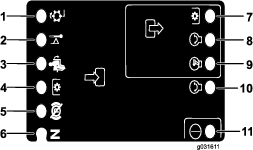
To troubleshoot the SCM device, do the following steps:
-
Determine the output fault that you are trying to resolve (PTO, START, or ETR).
-
Move key switch to the ON position and ensure that the red, power LED illuminates.
-
Move all of the input switches to ensure that all LEDs change state.
-
Position the input devices at the appropriate position to achieve the appropriate output.
Note: Use the following logic chart to determine the appropriate input condition.
-
Review the following repair options if a specific output LED illuminates.
-
If a specific output LED illuminates without the appropriate output function, check the output harness, connections, and component.
Note: Repair as required.
-
If a specific output LED does not illuminate, check both fuses.
-
If a specific output LED does not illuminate and the inputs are in the appropriate condition, install a new SCM and determine if the fault disappears.
-
Each row (across) in the logic chart below identifies input and output requirements for each specific product function. Product functions are listed in the left column. Symbols identify specific circuit condition, including energized to voltage, closed to ground, and open to ground.
| Inputs | Outputs | ||||||||||
|---|---|---|---|---|---|---|---|---|---|---|---|
| Function | Power ON | In NEUTRAL | Start ON | Brake ON | PTO ON | In Seat | Hi Temp | Backlap | Start | ETR | PTO |
| Start | — | — | + | O | O | — | O | O | + | + | O |
| Run (Off Unit) | — | — | O | O | O | O | O | O | O | + | O |
| Run (On Unit) | — | O | O | — | O | — | O | O | O | + | O |
| Mow | — | O | O | — | — | — | O | O | O | + | + |
| Backlap | — | — | O | O | — | O | O | — | O | + | + |
| Hi Temp | — | O | — | O | O | O | |||||
-
(–) Indicates a circuit closed to ground—LED On
-
(O) Indicates a circuit open to ground or de-energized—LED Off
-
(+) Indicates an energized circuit (clutch coil, solenoid, or start input)—LED On
-
A blank indicates a circuit that is not involved with the logic chart.
To troubleshoot, turn on the key without starting the engine. Identify the specific function that does not work and work across the logic chart. Inspect the condition of each input LED to ensure that it matches the logic chart.
If the input LEDs are correct, check the output LED. If the output LED illuminates but the device is not energized, measure the available voltage at the output device, the continuity of the disconnected device, and the potential voltage on the ground circuit (floating ground).
Operating Tips
Creating a Site Survey
To perform a site survey, lay a 1.25 m plank (4 ft long 2 x 4) on the slope surface and measure the angle of the slope with the inclinometer provided with the machine. The plank (2 x 4) will average the slope but will not take into consideration dips or holes which can cause a sudden change in side hill angle. After completing the site survey, refer to Before Operation Safety.
Additionally, the machine is equipped with an angle indicator mounted on the steering tube. This indicates the side hill angle that the machine is on.
Operating the Machine
-
Start the engine and run it at HALF IDLE until it warms up. Push the throttle lever all the way forward, lift the cutting units, disengage the parking brake, press the forward traction pedal, and carefully drive to an open area.
-
Practice moving forward and reverse, and starting and stopping the machine. To stop the machine, remove your foot from the traction pedal and let it return to NEUTRAL or press down on the reverse pedal. When going downhill in the machine, you may need to use the reverse pedal to stop.
-
Practice driving around obstacles with the cutting units up and down. Be careful when driving between narrow objects so that you do not damage the machine or cutting units.
-
On the Sidewinder unit, get accustomed to the reach of the cutting units so that you do not hang them up or damage them.
-
Do not shift the cutting units from side to side unless they are down and the machine is moving, or the cutting units are in the transport position. Shifting the cutting units when they are down and the machine is not moving may damage the turf.
-
Always drive slowly in rough areas.
-
The Sidewinder unit offers up to a maximum of 33 cm (13 inches) of overhang, allowing you to trim closer to the edge of sand traps and other obstacles, while, at the same time, keeping the tractor tires as far away from the edge of traps or water hazards as possible.
-
If an obstacle is in the way, shift the cutting units to mow around it.
-
When transporting the machine from 1 work area to another, raise the cutting units to the fully upward position, move the mow/transport slide to the left to transport, and place the throttle in the FAST position.
Changing Mowing Patterns
Change mowing patterns often to minimize a poor after-cut appearance from repeatedly mowing in the same direction.
Understanding Counterbalance
The counterbalance system maintains hydraulic back pressure on the cutting unit lift cylinders. This pressure improves traction by transferring the cutting unit weight to the mower-drive wheels. The counterbalance pressure has been set at the factory to an optimal balance of after-cut appearance and traction capability in most turf conditions.
Decreasing the counterbalance setting can produce a more stable cutting unit, but can decrease the traction capability. Increasing the counterbalance setting can increase the traction capability, but may result in a poor after-cut appearance. Refer to the machine Service Manual for your traction unit for instructions to adjust the counterbalance pressure.
Resolving After-Cut Appearance
Refer to the After-cut Appearance Troubleshooting Guide available at www.Toro.com.
Using Proper Mowing Techniques
-
To begin cutting, engage the cutting units, then approach the mowing area slowly. Once the front cutting units are over the mowing area, lower the cutting units.
-
To achieve the professional straight-line cut and striping that is desirable for some applications, find a tree or other object in the distance and drive straight toward it.
-
As soon as the front cutting units reach the edge of the mowing area, lift the cutting units, and perform a teardrop-shaped turn to quickly line up for your next pass.
-
To mow around bunkers, ponds, or other contours easily, use the Sidewinder unit and move the control lever to the left or right, depending on your mowing application. You can also shift the cutting units to vary the tire tracking.
-
The cutting units tend to throw grass to the left side of the machine. If you are trimming around bunkers, mow in a clockwise direction to prevent throwing clippings into the bunker.
-
Bolt-in mulching baffles are available for the cutting units. The mulching baffles perform well when you maintain turf on a regular schedule to avoid removing more than 25 mm (1 inch) of growth per cutting. When you cut too much growth with the mulching baffles installed, the after-cut appearance may deteriorate and the observed power to cut the turf increases. The mulching baffles also perform well for shredding leaves in the fall.
Selecting the Proper Height-of-Cut Setting to Suit Conditions
Remove no more than approximately 25 mm (1 inch), or 1/3 of the grass blade when cutting. In exceptionally lush and dense grass, you may need to raise your height-of-cut setting.
Mowing with Sharp Blades
A sharp blade cuts cleanly and without tearing or shredding the grass blades like a dull blade. Tearing and shredding causes the grass to turn brown at the edges, which impairs growth and increases susceptibility to diseases. Ensure that the blade is in good condition and that there is a full sail.
Checking the Condition of the Cutting Unit
Ensure that the cutting chambers are in good condition. Straighten any bends in the chamber components to ensure correct blade tip/chamber clearance.
Maintaining the Machine After Mowing
After mowing, thoroughly wash the machine with a garden hose with no nozzle to avoid contamination and damage to the seals and bearings caused by excessive water pressure. Ensure that the radiator and oil cooler are kept free of dirt or grass clippings. After cleaning, inspect the machine for possible hydraulic-fluid leaks, damage, or wear to the hydraulic and mechanical components, and check the cutting-unit blades for sharpness.
Important: After washing the machine, move the Sidewinder mechanism from left to right several times to remove the water between the bearing blocks and cross tube.
After Operation
General Safety
-
Shut off the engine, remove the key (if equipped), and wait for all movement to stop before you leave the operator’s position, Allow the machine to cool before adjusting, servicing, cleaning, or storing it.
-
Clean grass and debris from the cutting units, mufflers, and engine compartment to help prevent fires. Clean up oil or fuel spills.
-
If the cutting units are in the transport position, use the positive mechanical lock (if available) before you leave the machine unattended.
-
Allow the engine to cool before storing the machine in any enclosure.
-
Remove the key and shut off the fuel (if equipped) before storing or hauling the machine.
-
Never store the machine or fuel container where there is an open flame, spark, or pilot light, such as on a water heater or on other appliances.
-
Maintain and clean the seat belt(s) as necessary
Hauling the Machine
-
Remove the key and shut off the fuel (if equipped) before storing or transporting the machine.
-
Use care when loading or unloading the machine into a trailer or a truck.
-
Use full-width ramps for loading the machine into a trailer or a truck.
-
Tie the machine down securely.
Locating the Tie-Down Points
There are tie downs located at the front and rear sides of the machine (Figure 30).
Note: Use properly-rated DOT-approved straps in 4 corners to tie down the machine.
-
2 on the front of the operator's platform
-
Rear tire
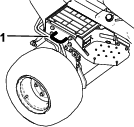

Pushing or Towing the Machine
In an emergency, you can move the machine a very short distance by actuating the bypass valve in the hydraulic pump and pushing or towing the machine.
Important: Do not push or tow the machine faster than 3 to 4.8 km/h (2 to 3 mph). If you push or tow at a faster speed, internal transmission damage may occur. If you must move the machine a considerable distance, transport it on a truck or trailer.
Important: The bypass valve must be open whenever you push or tow the machine. Close the valve once you have pushed or towed the machine to the desired location.
-
Locate the bypass valve on the pump (Figure 31) and loosen it by rotating 90° (1/4 of a turn).
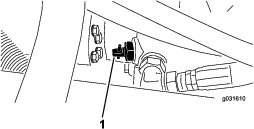
-
Push or tow the machine.
-
Finish pushing or towing the machine and close the bypass valve by rotating it 90° (1/4 turn).
Important: Ensure that the bypass valve is closed before you start the engine. Running the engine with an open bypass valve causes the transmission to overheat.
Maintenance
Note: Determine the left and right sides of the machine from the normal operating position.
Note: Download a free copy of the electrical or hydraulic schematic by visiting www.Toro.com and searching for your machine from the Manuals link on the home page.
Maintenance Safety
-
Before you leave the operator’s position, do the following:
-
Park the machine on a level surface.
-
Disengage the power takeoff and lower the attachments.
-
Engage the parking brake.
-
Shut off the engine and remove the key (if equipped).
-
Wait for all movement to stop.
-
-
Allow machine components to cool before performing maintenance.
-
If the cutting units are in the transport position, use the positive mechanical lock (if equipped) before you leave the machine unattended.
-
If possible, do not perform maintenance while the engine is running. Keep away from moving parts.
-
Support the machine with jack stands whenever you work under the machine.
-
Carefully release pressure from components with stored energy.
-
Keep all parts of the machine in good working condition and all hardware tightened, especially blade-attachment hardware.
-
Replace all worn or damaged decals.
-
To ensure safe, optimal performance of the machine, use only genuine Toro replacement parts. Replacement parts made by other manufacturers could be dangerous, and such use could void the product warranty.
Recommended Maintenance Schedule(s)
| Maintenance Service Interval | Maintenance Procedure |
|---|---|
| After the first hour |
|
| After the first 10 hours |
|
| After the first 50 hours |
|
| Before each use or daily |
|
| Every 25 hours |
|
| Every 50 hours |
|
| Every 100 hours |
|
| Every 150 hours |
|
| Every 200 hours |
|
| Every 400 hours |
|
| Every 500 hours |
|
| Every 800 hours |
|
| Every 1,000 hours |
|
| Every 2,000 hours |
|
| Before storage |
|
| Every 2 years |
|
Pre-Maintenance Procedures
Preparing the Machine for Maintenance
-
Ensure that the PTO is disengaged.
-
Park the machine on a level surface.
-
Engage the parking brake.
-
Lower the cutting unit(s) if necessary.
-
Shut off the engine and wait for all moving parts to stop.
-
Turn the ignition key to the STOP position and remove it.
-
Allow machine components to cool before performing maintenance.
Removing the Hood
-
Unlatch and raise the hood.
-
Remove the hairpin cotter securing the hood pivot to the mounting brackets (Figure 32).
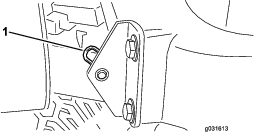
-
Slide the hood to the right side, lift the other side, and pull it out of the brackets.
Note: Reverse this procedure to install the hood.
Using the Cutting Unit Service Latch
When servicing the cutting units, use the service latch to prevent injury.
-
Center the cutting unit sidewinder with the traction unit.
-
Raise the cutting unit to the transport position.
-
Engage the parking brake and shut off the machine.
-
Release the latch rod from the front carrier-frame retainer (Figure 33).
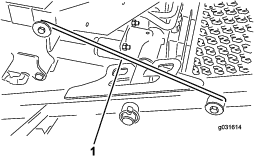
-
Lift the outside of the front cutting units and place the latch over the frame pin mounted on the front of the operator's platform (Figure 33).
-
Sit on the operator’s seat and start the machine.
-
Lower the cutting units to the mow position.
-
Turn off the machine and remove the key.
-
Reverse this procedure to unlatch the cutting units.
Lubrication
Greasing the Bearings and Bushings
| Maintenance Service Interval | Maintenance Procedure |
|---|---|
| Every 50 hours |
|
| Every 500 hours |
|
The machine has grease fittings that you must lubricate regularly with No. 2 lithium grease. Also, lubricate the machine immediately after every washing.
The grease fitting locations and quantities are as follows:
-
Rear cutting-unit pivot (Figure 34)

-
Front cutting-unit pivot (Figure 35)
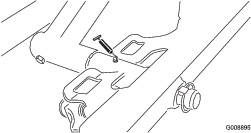
-
2 sidewinder-cylinder ends (Figure 36)
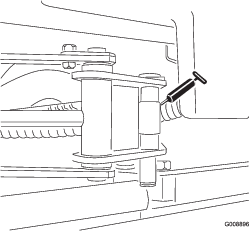
-
Steering pivot (Figure 37)
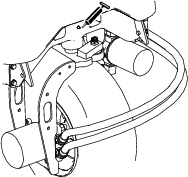
-
2 rear lift-arm pivots and lift cylinder (Figure 38)

-
2 left, front lift-arm pivots and lift cylinder (Figure 39)
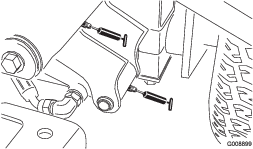
-
2 right, front lift-arm pivots and lift cylinder (Figure 40)

-
Neutral-adjustment mechanism (Figure 41)
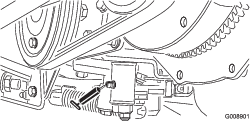
-
Mow/transport slide (Figure 42)
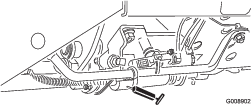
-
Belt-tension pivot (Figure 43)
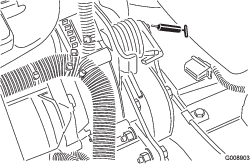
-
Steering cylinder (Figure 44)
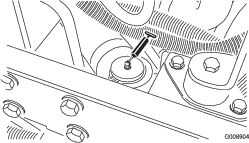
-
2 (per cutting unit) cutting unit spindle-shaft bearings (Figure 45)
Note: You can use either fitting, whichever is more accessible. Pump grease into the fitting until a small amount appears at the bottom of the spindle housing (under the cutting unit).

-
2 (per cutting unit) rear roller bearings (Figure 46)

Note: Ensure that the grease groove in each roller mount aligns with the grease hole in each end of the roller shaft. To help align the groove and hole, there is also an alignment mark on an end of the roller shaft.
Important: Do not lubricate the Sidewinder cross tube. The bearing blocks are self-lubricated.
Engine Maintenance
Engine Safety
-
Shut off the engine and remove the key before checking the oil or adding oil to the crankcase.
-
Do not change the governor speed or overspeed the engine.
Servicing the Air Cleaner
Check the air-cleaner body for damage that could cause an air leak and replace it if it is damaged. Check the entire intake system for leaks, damage, or loose hose clamps. Also, inspect the rubber intake-hose connections at the air cleaner and turbocharger to ensure that the connections are complete.
Ensure that the cover is seated correctly and seals with the air-cleaner body.
Servicing the Air-Cleaner Cover
| Maintenance Service Interval | Maintenance Procedure |
|---|---|
| Every 50 hours |
|
Check the air-cleaner body for damage which could cause an air leak. Replace a damaged air cleaner body.
Clean the air-cleaner cover (Figure 47).
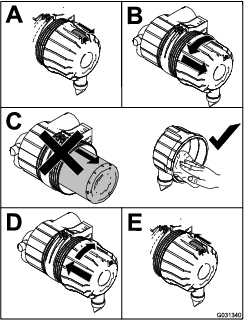
Servicing the Air-Cleaner Filter
| Maintenance Service Interval | Maintenance Procedure |
|---|---|
| Every 200 hours |
|
-
Before removing the filter, use clean and dry, low-pressure air (275 kPa or 40 psi) to help remove large accumulations of debris packed between the outside of the primary filter and the canister.
Important: Avoid using high-pressure air that could force dirt through the filter and into the intake tract, causing damage. This cleaning process prevents debris from migrating into the intake when you remove the primary filter.
-
Remove the primary filter (Figure 48).
Important: Do not clean the used element to prevent the possibility of damaging the filter media. Inspect the new filter for shipping damage, checking the sealing end of the filter and the body. Do not use a damaged element.
Important: Do not attempt to clean the safety filter. Replace the safety filter after every 3 primary-filter services (Figure 49).
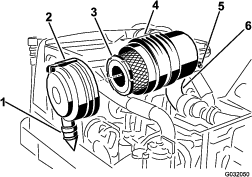

-
Replace the primary filter (Figure 48).
-
Insert the new filter by applying pressure to the outer rim of the element to seat it in the canister.
Note: Do not apply pressure to the flexible center of the filter.
-
Clean the dirt-ejection port located in the removable cover.
-
Remove the rubber outlet valve from the cover, clean the cavity, and replace the outlet valve.
-
Install the cover, orienting the rubber outlet valve in a downward position between the 5 o’clock to 7 o’clock positions when viewed from the end, and secure the latch (Figure 48).
Servicing the Engine Oil
Checking the Engine-Oil Level
| Maintenance Service Interval | Maintenance Procedure |
|---|---|
| Before each use or daily |
|
The engine is shipped with oil in the crankcase; however, check the oil level before and after you start the engine for the first time.
The crankcase capacity is approximately 2.8 L (4 US qt) with the filter.
Use Toro Premium Engine Oil or another high-quality, low-ash engine oil that meets or exceeds the following specifications:
-
API Classification Level Required: CH-4, CI-4, or higher.
-
Preferred oil: SAE 15W-40 above -17º C (0º F)
-
Alternate oil: SAE 10W-30 or 5W-30 (all temperatures)
Note: Toro Premium Engine Oil is available from your distributor in either 15W-40 or 10W-30 viscosity. Also, refer to the engine owner's manual (included with the machine) for further recommendations.
Note: The best time to check the engine oil is when the engine is cool before it has been started for the day. If you have already run the engine, allow the oil to drain back down to the sump for at least 10 minutes before checking. If the oil level is at or below the ADD mark on the dipstick, add oil to bring the oil level to the FULL mark. Do not overfill. If the oil level is between the FULL and ADD marks, you do not need to add oil.
Check the engine-oil level as shown in Figure 50.
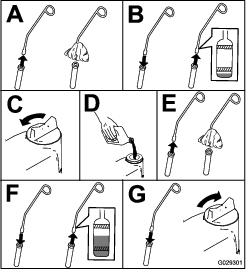
Changing the Engine Oil and Filter
| Maintenance Service Interval | Maintenance Procedure |
|---|---|
| After the first 50 hours |
|
| Every 150 hours |
|
-
Start the engine and let it run 5 minutes to allow the oil to warm up.
-
With the machine parked on a level surface, shut off the engine, remove the key, and wait for all moving parts to stop before leaving the operating position.
-
Change the engine oil as shown in Figure 51.
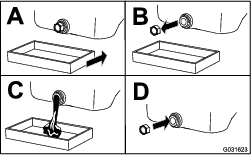
-
Change the engine-oil filter as shown in Figure 52.
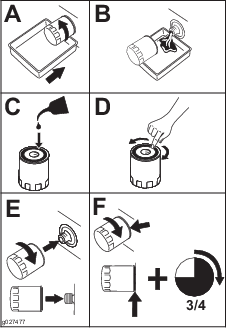
Fuel System Maintenance
Draining the Fuel Tank
| Maintenance Service Interval | Maintenance Procedure |
|---|---|
| Every 800 hours |
|
| Before storage |
|
In addition to the listed service interval, drain and clean the tank if the fuel system becomes contaminated or if you are storing the machine for an extended period. Use clean fuel to flush out the tank.
Inspecting the Fuel Lines and Connections
| Maintenance Service Interval | Maintenance Procedure |
|---|---|
| Every 400 hours |
|
Inspect the fuel lines for deterioration, damage, or loose connections.
Servicing the Water Separator
| Maintenance Service Interval | Maintenance Procedure |
|---|---|
| Before each use or daily |
|
| Every 400 hours |
|
Draining the Water Separator
-
Place a drain pan under the fuel filter.
-
Loosen the drain valve on the bottom of the filter (Figure 53).
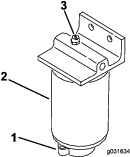
-
Tighten the valve after draining.
Replacing the Fuel Filter
-
Clean the area where the filter mounts (Figure 53).
-
Remove the filter and clean the mounting surface.
-
Lubricate the gasket on the filter with clean oil.
-
Install the filter by hand until the gasket contacts the mounting surface; then rotate an additional 1/2 turn.
Bleeding the Fuel System
-
Perform the pre-maintenance procedure; refer to Preparing the Machine for Maintenance
-
Ensure that the fuel tank is at least half full.
-
Unlatch and raise the hood.
Danger
Under certain conditions, diesel fuel and fuel vapors are highly flammable and explosive. A fire or explosion from fuel can burn you and others and can cause property damage.
Never smoke when handling fuel, and stay away from an open flame or where fuel fumes may be ignited by a spark.
-
Open the air-bleed screw on the fuel-injection pump (Figure 54).
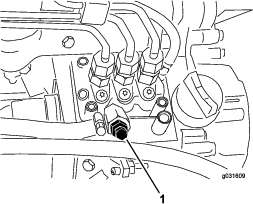
-
Turn the key in the ignition switch to the ON position.
Note: The electric fuel pump will operate, forcing air out around the air-bleed screw. Leave the key in the ON position until a solid stream of fuel flows out around the screw.
-
Tighten the screw and turn the key to the OFF position.
Note: Normally, the engine should start after performing this procedure. However, if the engine does not start, there may be air trapped between the injection pump and injectors; refer to Bleeding Air from the Injectors.
Bleeding Air from the Injectors
Note: Use this procedure only if the fuel system has been purged of air through normal priming procedures and the engine does not start; refer to Bleeding the Fuel System.
-
Loosen the pipe connection to the No. 1 nozzle and holder assembly (Figure 55).
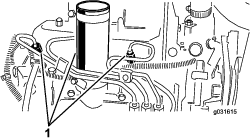
-
Move the throttle to the FAST position.
-
Turn the key in the key switch to the START position and watch the fuel flow around the connector.
Note: Turn the key to the OFF position when solid flow is observed.
-
Tighten the pipe connector securely.
-
Repeat this procedure on the remaining nozzles.
Electrical System Maintenance
Electrical System Safety
-
Disconnect the battery before repairing the machine. Disconnect the negative terminal first and the positive last. Connect the positive terminal first and the negative last.
-
Charge the battery in an open, well-ventilated area, away from sparks and flames. Unplug the charger before connecting or disconnecting the battery. Wear protective clothing and use insulated tools.
Servicing the Battery
| Maintenance Service Interval | Maintenance Procedure |
|---|---|
| Every 25 hours |
|
Maintain the battery-electrolyte level properly and keep the top of the battery. If you store the machine in a hot location, the battery will discharge more rapidly than if you store the machine in a cool location.
Maintain the cell level with distilled or demineralized water. Do not fill the cells above the bottom of the split ring inside each cell. Install the filler caps with the vents pointing to the rear (toward the fuel tank).
Danger
Battery electrolyte contains sulfuric acid which is fatal if consumed and causes severe burns.
-
Do not drink electrolyte and avoid contact with skin, eyes, or clothing. Wear safety glasses to shield your eyes and rubber gloves to protect your hands.
-
Fill the battery where clean water is always available for flushing the skin.
Keep the top of the battery clean by washing it periodically with a brush dipped in ammonia or a solution of bicarbonate of soda. Flush the top surface with water after cleaning. Do not remove the filler caps while cleaning the battery.
The battery cables must be tight on the terminals to provide good electrical contact.
Warning
Incorrectly routing the battery cable could damage the tractor and cables, causing sparks. Sparks can cause the battery gases to explode, resulting in personal injury.
-
Always disconnect the negative (black) battery cable before disconnecting the positive (red) cable.
-
Always connect the positive (red) battery cable before connecting the negative (black) cable.
If the terminals have corrosion, disconnect the cables (the negative (–) cable first) and scrape the clamps and terminals separately. Connect the cables (positive (+) cable first) and coat the terminals with petroleum jelly.
Servicing the Fuses
The fuses in machines electrical system are located under console cover.
If the machine stops or has other electrical system issues, check the fuses. Grasp each fuse in turn and remove them 1 at a time, checking if any are blown.
Important: If you need to replace a fuse, always use the same type and amperage-rated fuse as the one you are replacing, otherwise you could damage the electrical system. Refer to the decal next to the fuses for a diagram of each fuse and its amperage.
Note: If a fuse blows frequently, you probably have a short in the electrical system and should have it serviced by a qualified service technician.
Drive System Maintenance
Checking the Tire Pressure
| Maintenance Service Interval | Maintenance Procedure |
|---|---|
| Before each use or daily |
|
Danger
Low tire pressure decreases machine side-hill stability. This could cause a rollover, which may result in personal injury or death.
Do not underinflate the tires.
The correct air pressure in the tires is 97 to 124 kPa (14 to 18 psi) as shown in Figure 56.
Important: Maintain pressure in all tires to ensure a good quality of cut and proper machine performance.Check the air pressure in all the tires before operating the machine.
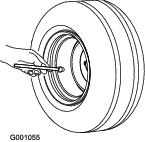
Checking the Torque of the Wheel-Lug Nuts
| Maintenance Service Interval | Maintenance Procedure |
|---|---|
| After the first hour |
|
| After the first 10 hours |
|
| Every 200 hours |
|
Torque the wheel-lug nuts to 61 to 88 N∙m (45 to 65 ft-lb).
Warning
Failing to maintain proper torque of the wheel-lug nuts could result in personal injury.
Torque the wheel-lug nuts to the proper torque value.
Adjusting the Traction Drive for Neutral
If the machine moves when the traction pedal is in the NEUTRAL position, adjust the traction cam.
-
Park the machine on a level surface, lower the cutting units, engage the parking brake, shut off the engine, and remove the key from the ignition switch.
-
Chock or block the front and rear wheels on one side.
-
Raise the opposite front and rear wheel off the floor and place support blocks under the frame.
Warning
If the machine is not supported adequately, it may accidentally fall, injuring anyone under the machine.
A front wheel and a rear wheel must be raised off the ground; otherwise, the machine will move during adjustment.
-
Loosen the locknut on the traction adjustment cam (Figure 57).
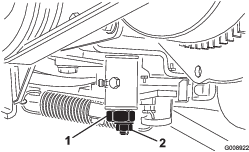
Warning
The engine must be running so that you can make a final adjustment of the traction adjustment cam. Contact with hot or moving parts can result in personal injury.
Keep your hands, feet, face, and other body parts away from the muffler, other hot parts of the engine, and rotating parts.
-
Start the engine and rotate the cam hex in both directions to determine the mid position of the neutral span.
-
Tighten the locknut securing the adjustment.
-
Shut off the engine.
-
Remove the support blocks and lower the machine to the shop floor. Test drive the machine to ensure that it does not move when the traction pedal is in neutral.
Cooling System Maintenance
Cooling System Safety
-
Swallowing engine coolant can cause poisoning; keep out of reach from children and pets.
-
Discharge of hot, pressurized coolant or touching a hot radiator and surrounding parts can cause severe burns.
-
Always allow the engine to cool at least 15 minutes before removing the radiator cap.
-
Use a rag when opening the radiator cap, and open the cap slowly to allow steam to escape.
-
-
Do not operate the machine without the covers in place.
-
Keep your fingers, hands and clothing clear of rotating fan and drive belt.
Checking the Cooling System
| Maintenance Service Interval | Maintenance Procedure |
|---|---|
| Before each use or daily |
|
Clean any debris off of the radiator (Figure 58).
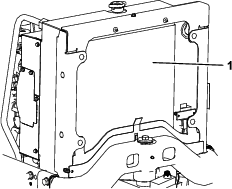
Clean the radiator hourly if conditions are extremely dusty and dirty; refer to Cleaning the Cooling System.
The cooling system is filled with a 50/50 solution of water and permanent ethylene glycol anti-freeze. Check the coolant level at the beginning of each day before starting the engine.
The capacity of the cooling system is approximately 5.7 L (6 US qt).
Caution
If the engine has been running, the pressurized, hot coolant can escape and cause burns.
-
Do not open the radiator cap when the engine is running.
-
Use a rag when opening the radiator cap, and open the cap slowly to allow steam to escape.
-
Check the coolant level in the expansion tank (Figure 59).
Note: With a cold engine, the coolant level should be approximately midway between the marks on the side of the tank.
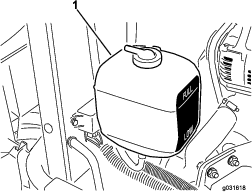
-
If the coolant level is low, remove the expansion-tank cap and replenish the system.
Note: Do not overfill.
-
Install the expansion-tank cap.
Cleaning the Cooling System
| Maintenance Service Interval | Maintenance Procedure |
|---|---|
| Before each use or daily |
|
-
Raise the hood.
-
Clean the engine area thoroughly of all debris.
-
With compressed air, start from the front of the radiator and blow the debris out toward the back.
-
Clean the radiator from the back side and blow toward the front.
Note: Repeat the procedure several times until you remove all chaff and debris.
Important: Cleaning the radiator with water promotes premature corrosion damage to components and compacts debris.

-
Close and latch the hood.
Brake Maintenance
Adjusting the Parking Brake
| Maintenance Service Interval | Maintenance Procedure |
|---|---|
| Every 200 hours |
|
-
Loosen the set screw securing the knob to the parking-brake lever (Figure 61).
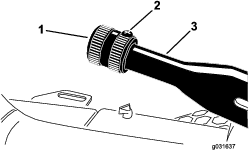
-
Torque the knob to 41 to 68 N∙m (30 to 40 in-lb) to actuate the lever.
-
Tighten the set screw.
Belt Maintenance
Servicing the Engine Belts
| Maintenance Service Interval | Maintenance Procedure |
|---|---|
| After the first 10 hours |
|
| Every 100 hours |
|
Checking the Alternator-Belt Tension
-
Open the hood.
-
Apply 30 N (22 in-lb) of force to the alternator belt, midway between the pulleys (Figure 62).
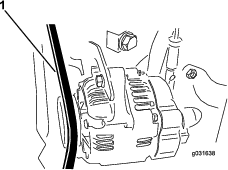
-
If the belt does not deflect 11 mm (7/16 inch), complete the following procedure to tension the belt:
-
Loosen the bolt securing the brace to the engine and the bolt securing the alternator to the brace.
-
Insert a pry bar between the alternator and engine, and pry out at the alternator.
-
When you obtain the proper tension, tighten the alternator and brace bolts to secure the adjustment.
-
Replacing the Hydrostat-Drive Belt
-
Insert a nut driver or small piece of tubing onto the end of the belt-tensioning spring.
Caution
The spring that tensions the belt is under a heavy load, and releasing the tension of the spring improperly may cause injury.
Use care when de-tensioning the spring and replacing the belt.
-
Push down and forward on the spring end to unhook it from the bracket and release tension on the spring (Figure 63).
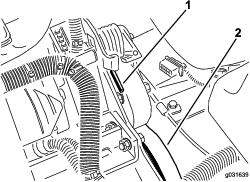
-
Replace the belt.
-
Reverse this procedure to tension the spring.
Controls System Maintenance
Adjusting the Throttle
-
Position the throttle lever rearward so that it stops against the control-panel slot.
-
Loosen the throttle-cable connector on the injection-pump-lever arm (Figure 64).
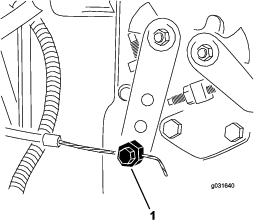
-
Hold the injection-pump-lever arm against the low-idle stop and tighten the cable connector.
-
Loosen the screws securing the throttle control to the control panel.
-
Push the throttle-control lever completely forward.
-
Slide the stop plate until it contacts the throttle lever and tighten the screws securing the throttle control to the control panel.
-
If the throttle does not stay in position during operation, torque the locknut, used to set the friction device on the throttle lever, to 5 to 6 N∙m (40 to 55 in-lb).
Note: The maximum force required to operate the throttle lever should be 27 N∙m (20 in-lb).
Hydraulic System Maintenance
Hydraulic System Safety
-
Seek immediate medical attention if fluid is injected into skin. Injected fluid must be surgically removed within a few hours by a doctor.
-
Ensure that all hydraulic-fluid hoses and lines are in good condition and all hydraulic connections and fittings are tight before applying pressure to the hydraulic system.
-
Keep your body and hands away from pinhole leaks or nozzles that eject high-pressure hydraulic fluid.
-
Use cardboard or paper to find hydraulic leaks.
-
Safely relieve all pressure in the hydraulic system before performing any work on the hydraulic system.
Servicing the Hydraulic Fluid
Hydraulic Fluid Specifications
The reservoir is filled at the factory with high-quality hydraulic fluid. Check the level of the hydraulic fluid before you first start the engine and daily thereafter; refer to Checking the Hydraulic Fluid Level.
Recommended hydraulic fluid: Toro PX Extended Life Hydraulic Fluid; available in 19 L (5 US gallon) pails or 208 L (55 US gallon) drums.
Note: A machine using the recommended replacement fluid requires less frequent fluid and filter changes.
Alternative hydraulic fluids: If Toro PX Extended Life Hydraulic Fluid is not available, you may use another conventional, petroleum-based hydraulic fluid having specifications that fall within the listed range for all the following material properties and that it meets industry standards. Do not use synthetic fluid. Consult with your lubricant distributor to identify a satisfactory product.
Note: Toro does not assume responsibility for damage caused by improper substitutions, so use products only from reputable manufacturers who will stand behind their recommendation.
| Material Properties: | ||
| Viscosity, ASTM D445 | cSt @ 40°C (104°F) 44 to 48 | |
| Viscosity Index ASTM D2270 | 140 or higher | |
| Pour Point, ASTM D97 | -37°C to -45°C (-34°F to -49°F) | |
| Industry Specifications: | Eaton Vickers 694 (I-286-S, M-2950-S/35VQ25 or M-2952-S) | |
Note: Many hydraulic fluids are almost colorless, making it difficult to spot leaks. A red dye additive for the hydraulic fluid is available in 20 ml (0.67 fl oz) bottles. A bottle is sufficient for 15 to 22 L (4 to 6 US gallons) of hydraulic fluid. Order Part No. 44-2500 from your authorized Toro distributor.
Important: Toro Premium Synthetic Biodegradable Hydraulic Fluid is the only synthetic biodegradable fluid approved by Toro. This fluid is compatible with the elastomers used in Toro hydraulic systems and is suitable for a wide-range of temperature conditions. This fluid is compatible with conventional mineral oils, but for maximum biodegradability and performance, the hydraulic system should be thoroughly flushed of conventional fluid. The oil is available in 19 L (5 US gallons) pails or 208 L (55 US gallons) from your authorized Toro distributor.
Checking the Hydraulic Fluid Level
| Maintenance Service Interval | Maintenance Procedure |
|---|---|
| Before each use or daily |
|
-
Perform the pre-maintenance procedure; refer to Preparing the Machine for Maintenance.
-
Clean the area around the filler neck and hydraulic-tank cap (Figure 65).
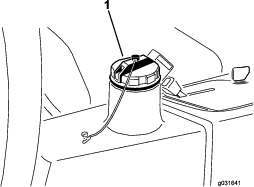
-
Remove the hydraulic-tank cap (Figure 65).
-
Remove the dipstick from the filler neck and wipe it with a clean rag.
-
Insert the dipstick into the filler neck, then remove it and check the fluid level.
Note: The fluid level should be within 6 mm (1/4 inch) of the mark on the dipstick.
-
If the level is low, add the appropriate fluid to raise the level to the FULL mark.
-
Install the dipstick and cap onto the filler neck.
Changing the Hydraulic Fluid
| Maintenance Service Interval | Maintenance Procedure |
|---|---|
| Every 800 hours |
|
| Every 2,000 hours |
|
| Every 2 years |
|
Hydraulic Fluid Capacity: 13.2 L (3.5 US gallons)
If the fluid becomes contaminated, contact your local Toro distributor to flush the system. Contaminated fluid looks milky or black.
-
Turn the engine off and raise the hood.
-
Disconnect the hydraulic line or remove the hydraulic filter and let the hydraulic fluid flow into a drain pan (Figure 68 and Figure 66).
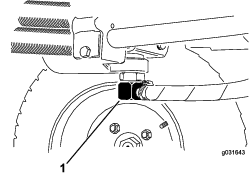
-
Install the hydraulic line when the hydraulic fluid stops draining (Figure 66).
-
Fill the reservoir (Figure 67) with approximately 13.2 L (3.5 US gallons) of hydraulic fluid; refer to Hydraulic Fluid Specifications and Checking the Hydraulic Fluid Level.
Important: Use only the hydraulic fluids specified. Other fluids could damage the system.

-
Install the reservoir cap.
-
Start the engine.
-
Use all the hydraulic controls to distribute the hydraulic fluid throughout the system, check for leaks, then shut off the engine.
-
Check the fluid level and add enough to raise the level to the FULL mark on the dipstick.
Note: Do not overfill.
Changing the Hydraulic Filter
| Maintenance Service Interval | Maintenance Procedure |
|---|---|
| Every 800 hours |
|
| Every 1,000 hours |
|
Use a genuine Toro replacement filter (Part No. 86-3010).
Important: Using any other filter may void the warranty on some components.
-
Perform the pre-maintenance procedure; refer to Preparing the Machine for Maintenance.
-
Pinch off the hose to the filter-mounting plate.
-
Clean around the filter-mounting area, place a drain pan under the filter, and remove the filter (Figure 68).
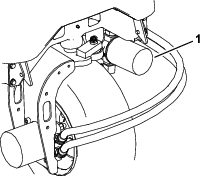
-
Lubricate the new filter gasket and fill the filter with hydraulic fluid.
-
Ensure that the filter mounting area is clean and screw the filter on until the gasket contacts the mounting plate; then tighten the filter 1/2 turn.
-
Release the hose to the filter-mounting plate.
-
Start the engine and let it run for approximately 2 minutes to purge air from the system.
-
Shut off the engine and check for leaks.
Checking the Hydraulic Lines and Hoses
| Maintenance Service Interval | Maintenance Procedure |
|---|---|
| Before each use or daily |
|
| Every 2 years |
|
Check the hydraulic lines and hoses for leaks, kinked lines, loose mounting supports, wear, loose fittings, weather deterioration, and chemical deterioration. Make all necessary repairs before operating the machine.
Cutting Unit Maintenance
Separating the Cutting Units from the Traction Unit
-
Perform the pre-maintenance procedure; refer to Preparing the Machine for Maintenance.
-
Remove the hydraulic-motor-mounting screws and disconnect and remove the hydraulic motor from the cutting unit (Figure 69).
Important: Cover the top of the spindle to prevent contamination.
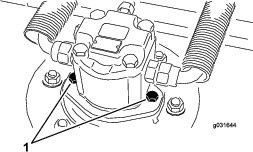
-
Remove the lynch pin or retaining nut securing the cutting unit carrier frame to the lift-arm-pivot pin (Figure 70).

-
Roll the cutting unit away from the traction unit.
Mounting the Cutting Units to the Traction Unit
-
Perform the pre-maintenance procedure; refer to Preparing the Machine for Maintenance.
-
Move the cutting unit into position in front of the traction unit.
-
Slide the cutting unit carrier frame onto the lift-arm-pivot pin and secure it with the lynch pin or retaining nut (Figure 70).
-
Using the hydraulic-motor-mounting screws, install the hydraulic motor to the cutting unit (Figure 69).
Note: Ensure that the O-ring is properly positioned and not damaged.
-
Grease the spindle.
Servicing the Blade Plane
The rotary cutting unit comes from the factory preset at 5 cm (2 inches) height-of-cut and blade rake of 7.9 mm (0.31 inch). The left and right heights of cut are also preset to within ± 0.7 mm (0.03 inch) of the other.
The cutting unit is designed to withstand blade impacts without deforming the chamber. If the blade strikes a solid object, inspect the blade for damage and the blade plane for accuracy.
Inspecting the Blade Plane
-
Remove the hydraulic motor from the cutting unit and remove the cutting unit from the traction unit.
Note: Use a hoist (or a minimum of 2 people) and place the cutting unit on a flat table.
-
Mark an end of the blade with a paint pen or marker.
Note: Use this end of the blade to check all heights.
-
Position the cutting edge of the marked end of the blade at the 12 o’clock position (straight ahead in the direction of mowing) and measure the height from the table to the cutting edge of the blade (Figure 71).
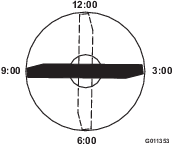
-
Rotate the marked end of the blade to the 3 o’clock and 9 o’clock positions and measure the heights (Figure 71).
-
Compare the 12 o’clock position measured height to the height-of-cut setting.
Note: It should be within 0.7 mm (0.03 inch). The 3 o’clock and 9 o’clock heights should be 3.8 ± 2.2 mm (0.15 ± 0.09 inch) higher than the 12 o’clock setting and within 2.2 mm (0.09 inch) of each other.
If any of these measurements are not within specification, proceed to Adjusting the Blade Plane.
Adjusting the Blade Plane
Start with the front adjustment (change 1 bracket at a time).
-
Remove the height-of-cut bracket (front, left, or right) from the cutting unit frame (Figure 72).
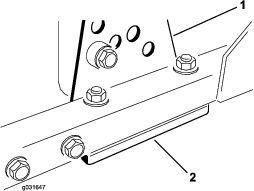
-
Adjust the 1.5 mm (0.06 inch) shims and/or 0.7 mm (0.03 inch) shim between the cutting unit frame and bracket to achieve the desired height of cut (Figure 72).
-
Install the height-of-cut bracket to the cutting unit frame with the remaining shims assembled below the height-of-cut bracket (Figure 72).
-
Secure the socket-head bolt and spacer and flange nut.
Note: The socket-head bolt and spacer are held together with thread-locking compound to prevent the spacer from falling inside the cutting unit frame.
-
Verify the 12 o’clock position setting and adjust if needed.
-
Determine if you need to adjust only 1 or both (right and left side) height-of-cut brackets.
Note: If the 3 o’clock or 9 o’clock side is 1.6 to 6.0 mm (0.06 to 0.24 inch) higher than the new front height, then you do not need to adjust for that side. Adjust the other side to within ± 2.2 mm (0.09 inch) of the correct side.
-
Adjust the right and/or left height-of-cut brackets by repeating steps 1 through 3.
-
Secure the carriage bolts and flange nuts.
-
Verify the 12, 3, and 9 o’clock heights.
Servicing the Front Roller
Inspect the front roller for wear, excess wobble, or binding. Service or replace the roller or components if any of these conditions exist.
Removing the Front Roller
-
Remove the roller-mounting bolt (Figure 73).
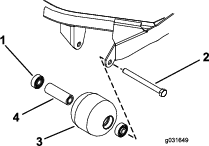
-
Insert a punch through the end of the roller housing and drive the opposite bearing out by alternating taps to the opposite side of inner-bearing race.
Note: There should be a 1.5 mm (0.06 inch) lip of inner race exposed.
-
Push the second bearing out in the press.
-
Inspect the roller housing, bearings, and bearing spacer for damage (Figure 73).
Note: Replace damaged components and assemble the front roller.
Installing the Front Roller
-
Pressing on the outer race only or equally on the inner and outer race, press the first bearing into the roller housing (Figure 73).
Note: Press on the outer race only or equally on the inner and outer race.
-
Insert the spacer (Figure 73).
-
Pressing on outer race only or equally on the inner and outer race, press the second bearing into the roller housing until it contacts the spacer (Figure 73).
-
Install the roller assembly into the cutting unit frame.
Important: Securing the roller assembly with a gap larger than 1.5 mm (0.06 inch) creates a side load on the bearing and can lead to premature bearing failure.
-
Verify that there is no more than a 1.5 mm (0.06 inch) gap between the roller assembly and the roller-mount brackets of the cutting unit frame.
Note: If there is a gap over 1.5 mm (0.06 inch), install enough 5/8-inch diameter washers to take up the slop.
-
Torque the mounting bolt to 108 N∙m (80 ft-lb).
Blade Safety
-
Inspect the blade periodically for wear or damage.
-
Use care when checking the blades. Wrap the blades or wear gloves, and use caution when servicing the blades. Only replace or sharpen the blades; never straighten or weld them.
-
On multi-bladed machines, take care as rotating 1 blade can cause other blades to rotate.
Servicing the Blade
Removing and Installing the Cutting-Unit Blade(s)
Replace the blade if it hits a solid object, is out of balance, or is bent. Always use genuine Toro replacement blades to ensure safety and optimum performance.
-
Park the machine on a level surface, raise the cutting unit to the highest position, engage the parking brake, shut off the engine, and remove the key.
Note: Block the cutting unit to prevent it from accidentally falling.
-
Grasp the end of the blade using a rag or thickly-padded glove.
-
Remove the blade bolt, anti-scalp cup, and blade from the spindle shaft (Figure 74).
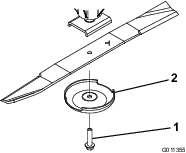
-
Install the blade, anti-scalp cup, and blade bolt and tighten the blade bolt to 115 to 149 N∙m (85 to 110 ft-lb).
Important: The curved part of the blade must be pointing toward the inside of the cutting unit to ensure proper cutting.
Note: After striking a foreign object, torque all spindle-pulley nuts to 115 to 149 N∙m (85 to 110 ft-lb).
Inspecting and Sharpening the Blade
Note: Check the blade before using the machine. Sand and abrasive material can wear away the metal that connects the flat and curved parts of the blade. If you notice wear, replace the blade; refer to Inspecting and Sharpening the Blade.
-
Perform the pre-maintenance procedure; refer to Preparing the Machine for Maintenance.
-
Block the cutting unit to prevent it from falling accidentally.
-
Examine the cutting ends of the blade carefully, especially where the flat and curved parts of the blade meet (Figure 75).
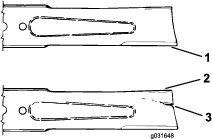
-
Inspect the cutting edges of all the blades. Sharpen the cutting edges if they are dull or nicked, sharpen only the top of the cutting edge, and maintain the original cutting angle to ensure sharpness (Figure 76).
Note: The blade remains balanced if the same amount of metal is removed from both cutting edges.

-
Lay the blade on a level surface and check its ends to ensure that the blade is straight and parallel.
Note: Position the ends of the blade slightly lower than the center, and the cutting edge lower than the heel of the blade. This blade produces a good quality of cut and requires minimal power from the engine. By contrast a blade that is higher at the ends than the center, or if cutting edge is higher than the heel, the blade is bent or warped and must be replaced.
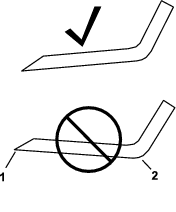
Note: The blade ends must be slightly lower than the center, and the cutting edge must be lower than the heel of the blade. These characteristics produce a good quality of cut and require less power from the engine.
Note: If the blade ends are higher than the center, or if the blade cutting edges are higher than the heel, replace the blade. These characteristics indicate that the blade is bent or warped.
-
Use the anti-scalp cup and blade bolt to install the blade with the sail facing toward the cutting unit.
-
Tighten the blade bolt to 115 to 149 N∙m (85 to 110 ft-lb).
Checking the Blade Stopping Time
| Maintenance Service Interval | Maintenance Procedure |
|---|---|
| Before each use or daily |
|
The cutting unit blades should stop within 7 seconds after you shut off the cutting units.
Note: Ensure that the cutting units are lowered onto a clean section of turf or hard surface to avoid thrown dust and debris.
To verify the stopping time, have an assistant stand at least 6 m (20 ft) away from the cutting unit and watch the blades on 1 of the cutting units. Shut off the cutting units and record the time that it takes for the blades to come to a complete stop. If the time is longer than 7 seconds, the braking valve needs adjustment; contact your authorized Toro distributor for assistance in making this adjustment.
Storage
Storage Safety
-
Shut off the engine, remove the key (if equipped), and wait for all movement to stop before you leave the operator’s position. Allow the machine to cool before adjusting, servicing, cleaning, or storing it.
-
Do not store the machine or fuel container where there is an open flame, spark, or pilot light, such as on a water heater or other appliance.
Preparing the Machine for Storage
Important: Do not use brackish or reclaimed water to clean the machine.
Preparing the Traction Unit
-
Thoroughly clean the traction unit, cutting units, and engine.
-
Check the tire pressure; refer to Checking the Tire Pressure.
-
Check all fasteners for looseness and tighten them as necessary.
-
Grease all grease fittings and pivot points. Wipe up any excess lubricant.
-
Lightly sand and use touch-up paint on painted areas that are scratched, chipped, or rusted. Repair any dents in the metal body.
-
Service the battery and cables as follows:
-
Remove the battery terminals from the battery posts.
Note: Always disconnect the negative terminal first and the positive last. Always connect the positive terminal first and the negative last.
-
Clean the battery, terminals, and posts with a wire brush and baking soda solution.
-
Coat the cable terminals and battery posts with Grafo 112X skin-over grease (Part Number 505-47) or petroleum jelly to prevent corrosion.
-
Slowly recharge the battery every 60 days for 24 hours to prevent lead sulfation of the battery.
-
Preparing the Engine
-
Drain the engine oil from the oil pan and replace the drain plug.
-
Remove and discard the oil filter. Install a new oil filter.
-
Refill the oil pan with designated quantity of motor oil.
-
Turn the key in the switch to the ON position, start the engine, and run it at idle speed for approximately 2 minutes.
-
Turn the key in the switch to the OFF position.
-
Thoroughly drain all fuel from the fuel tank, lines, and the fuel filter/water separator assembly.
-
Flush the fuel tank with fresh, clean diesel fuel.
-
Secure all fuel-system fittings.
-
Thoroughly clean and service the air-cleaner assembly.
-
Seal the air-cleaner inlet and the exhaust outlet with weatherproof tape.
-
Check the antifreeze protection and add as needed for expected minimum temperature in your area.
Storing the Cutting Units
If a cutting unit is separated from the traction unit for any length of time, install a spindle plug in the top of the spindle to protect the spindle from dust and water.
